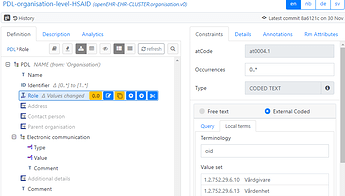When adding external terminology values to a DV_CODED_TEXT element in an archetype, the Archetype Designer apparently only allows adding them using URIs and constraints. In a lot of cases, legacy code sets don’t have any of those, but only a name, and at best an OID. We need to be able to add these value sets to the archetype manually. How can we do that?
That doesn’t seem right - the RM isn’t requiring URIs.
@siljelb did you figure out a way to use OIDs as codes in DV_CODED_TEXT using Archetype Designer?
I suspect we did it wrong in a project when we tried this:
I am confused regarding OIDs in tooling, What should it actually say in “Terminology” field for a coded text?
- oid
- urn:oid
- urn:oid:
- terminology:urn:oid
- Anything else?
And what about if we want to use an OID to describe a “Type” in an identifier - should the prefix be “oid”, “urn:oid” or something else? We likely guessed wrong here too:
Any hints from e.g. @ian.mcnicoll or @borut.fabjan or others?
We’ve just added the OID as the terminology Id. The same way as we use SNOMED-CT as terminology identifier for… You guessed right : SNOMED-CT.
@bna I’m not sure I follow. Do you mean that we actually guessed right regarding OID in both screenshots above (Coded text and Identifier)?
I think you’re looking at template modelling and not archetype modelling which the original post was about. It’s still not possible as far as I can see to add an external terminology set to an archetype-level DV_CODED_TEXT in AD using anything but URIs and constraints. I would guess though that using an OID identified value set using an URI would look something like this?
terminology://fhir.hl7.org/CodeSystem?url=urn:oid:1.2.752.29.6.10
But regarding your specific problem: I would have guessed that your OIDs 1.2.752.29.6.10 and 1.2.752.29.6.13 were value sets and not specific values within a value set? So I’d guess the full OID would go in the ‘Terminology’ field, prefixed by… something, I don’t know what. But presumably oid: at the very least? Then the values from within that value set would go in the ‘Value set’ field.
Almost the same way as we do. Except: We don’t add the oid:: prefix.
It might be that you are right doing this way of prefixing. Then we have to see how we do SNOMED-CT prefix:
SNOMED-CT::<some url>
SNOMED-CT
<some url>

